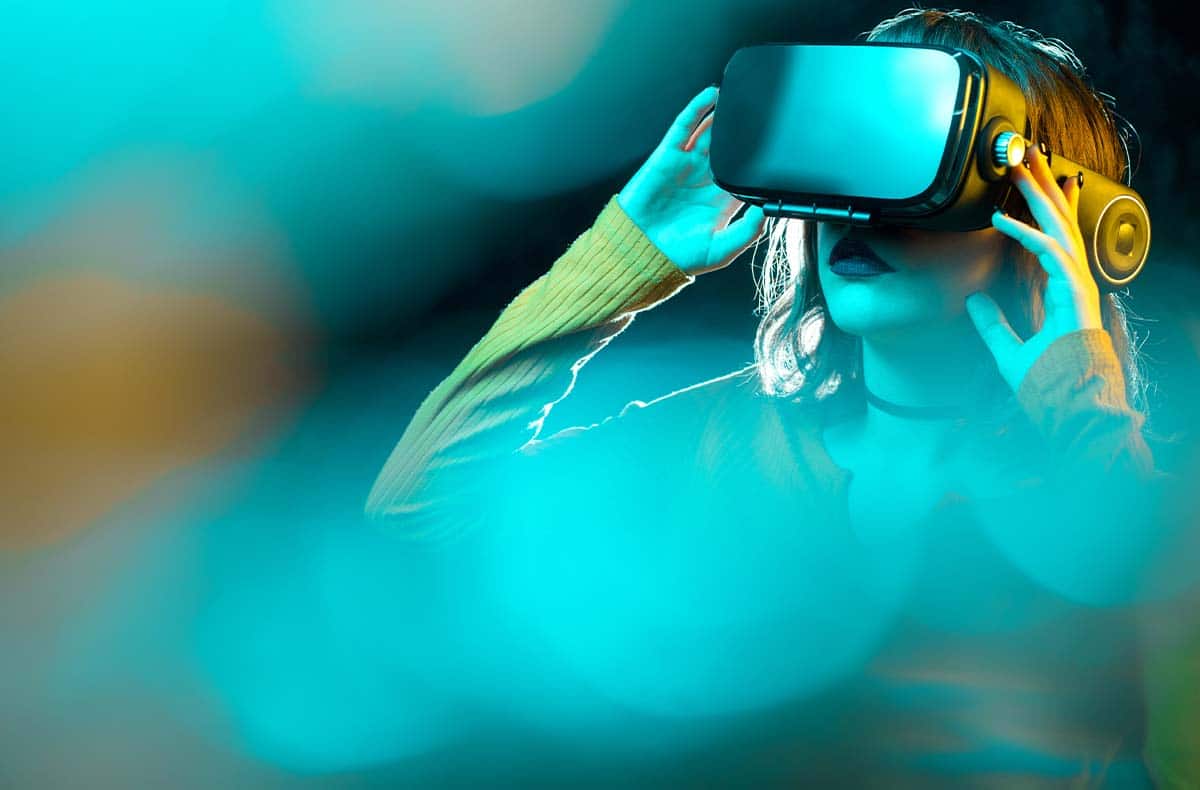
In our new pandemic-tinged reality, there’s dual trends in the performing arts that at first glance seem counterintuitive: immersive shows and virtual reality performances. While neither are yet fully mainstream, they are both undeniably on an upward trend, with immersive leading the charge as we tiptoe towards the metaverse.
Back at the start of 2000s, immersive theatrical experiences—where the fourth wall is fully gone and audiences are swept into the story they’re witnessing—were generally limited to haunted houses. Mainstream theatre sometimes played with immersive elements for a quick thrill, like actors crawling through the audience in productions like Cats or The Lion King—it’s a feline thing, apparently—or the Act I finale chandelier drop in The Phantom of the Opera (spoiler alert!), but British theatre company Punchdrunk’s site-specific Macbeth adaptation, Sleep No More, proved immersive theatre was more than a gimmick, and could succeed outside of the horror genre. After years of development that started in London in 2003, the production moved to the US, where it has garnered huge audiences, critical acclaim and awards for the better part of a decade. Indeed, it is still a popular attraction at New York’s McKittrick Hotel.
In recent years, countless other immersive events have cropped up with increasing frequency: the cutting-edge art collective Meow Wolf, which began in Santa Fe in 2016, now also produces “unforgettable, transformational” immersive art experiences for audiences in Denver and Las Vegas, while alluring Instagram photo-op ready events like Immersive Van Gogh have flooded our feeds with targeted ads for months. At a more intimate yet corporate level, if you’ve been lucky enough to land an invite to a trendy launch event, you might also have experienced “branded activations” produced by teams like MetaForYou, where beyond the red carpet, actors are waiting to pull you into a live, interactive experience that complements whatever you’re there for in the first place.
The level of interaction in immersive shows varies—in Sleep No More, audiences are asked not to speak, but are free to wander through the space at will, while in other activations, you might find yourself standing fully face-to-face with an actor staring into the depths of your soul, asking you questions you’re expected to answer. But the main defining factor all of these experiences share is that the audience is central to the experience itself, and the choices you make as a viewer matter. Unlike the movie theatre or darkened house past the proscenium, here, the audience does not sit back and passively receive, but is a central participant in the storytelling. The narrative you experience in Sleep No More will vary according to which character you choose to follow, which room you choose to enter; how you respond to the actor in an immersive one-on-one will alter the way they react.
Similarly, the budding field of VR theatre seeks to draw its audience into its world, rather than merely presenting it. At first glance, this tech-heavy medium seems the complete opposite of immersive theatre, where there is absolutely nothing standing between the performer and the viewer. Yet while operating through a veil of tech via motion capture and headsets, actors and audiences can find their way towards remarkably similar experiences, ones in which the audience feels sucked entirely into this narrative world. Although still in its nascent stages, VR theatre offers an intimacy and engagement adventurous audiences crave, with various options for levels of involvement. Even if it’s as simple as looking around a virtual space, watching a VR performance immediately incorporates more agency than a static camera angle. Not surprisingly, many of those drawn to immersive events are likely more willing to toss on an Oculus headset and see what’s what. Today, looking at the immersive art and entertainment review site, No Proscenium—which started in 2013 to cover the influx of indie immersive shows sweeping Southern California—you’ll find performances from across the globe, and an increasing number of virtual events as well.
Of course, one of the key appeals of immersive experiences is the very thing that made them seemingly impossible to maintain during the pandemic—and what threw jet fuel onto VR theatre’s acceleration. That is, of course, physical proximity. Dasha Kittredge, a seasoned immersive actor from Los Angeles and creative director of MetaForYou, described the shock of Covid-19 to live, in-person performance: “immersive was just gone entirely; theatre, plays, everything was just gone…collapsed onto the floor.” Having been deeply involved in LA’s immersive scene, Dasha was already becoming fluent in VR performance, which she saw flourishing during a time when in-person immersive was off limits. Sheltered in place, she was still able to connect to a virtual audience as an actor in art and game studio Tender Claws’ groundbreaking adaptation of Shakespeare’s The Tempest, “The Under Presents,” a first-of-its kind virtual production.
While it’s still an art form in development, real-time VR acting holds the potential to convey the same intimate connection to audience members that real-life immersive acting captures. Kittredge, who now teaches VR acting technique and is leading a workshop in the upcoming Next Stage Summit, describes how she’s learned to use gesture and movement in her avatar to evoke the same feeling of closeness for her audience that she’d achieve in a real world one-on-one moment. She describes it as very much still an imperfect art, which is highly dependent on the tech that mediates between the performer and audience member. In the past three years that live VR acting has been possible, Kittredge has seen the tech advance by leaps and bounds. One of the biggest gaps between live performance and VR is eye tracking, and the deep feeling of being seen that comes with a real gaze, but Kittredge notes platforms like AltSpace have already created an algorithm where avatars’ eyes move around a little and can actually “lock eyes”—or at least get the feel of it. There are all kinds of new innovations in the works that promise to bring higher levels of intimacy to virtual audiences, like adding haptic technologies that buzz, or other sensory elements, like smell. In our new metaverse, actors like Kittredge are learning how to adopt whatever tools are at their disposal to bring their storytelling to life in virtual spaces.
Not surprisingly, gaming has helped usher many into the virtual space: many other actors and creatives hungry to continue exploring their craft during lockdown found their way to this medium out of necessity. Of course, motion capture acting has been an art for decades now, from performers embodying video game characters to the King of Mocap, Andy Serkis, who’s more familiar to most as a talking ape, cave-dwelling Gollum or other CGI-rendered creature than human. But as technology has advanced—allowing live, real-time interaction—and grown more accessible and affordable, we’re seeing a sort of cottage industry of small VR productions emerge. Much in the way early YouTubers seized on new media to take creative control of their craft in the mid 2000s with home-produced web series, a small community of adventurous, industrious creatives are harnessing the potential of platforms like VRChat and Mozilla Hubs to create intimate virtual self-productions.
Brendan Bradley, a prolific and resourceful actor, writer, director and producer is taking bold moves to promote equity, experimentation and creative exploration in virtual reality. As a working actor who is presently performing in Welcome to Respite, the acclaimed first chapter of the virtual show The Severance Theory, Bradley invests his free time in sharing what he’s learned about virtual performance with as many others as he can reach. At NYU’s Tisch Drama school, he’s founded the interdepartmental Brendan Bradley Innovation Lab, a “collaborative initiative designed to foster innovation in live performance using digital media and technologies,” encouraging students to think creatively about performance and art in a digital space.
Outside of academia, he helped create OnBoardXR, a recurring online festival that supports the cultivation of experimental, original virtual works, with what Bradley terms “a ‘fringe festival’ meets ‘garage band’ approach to experimentation and troubleshooting.” Additionally, as a true believer in an open metaverse where all creators should “come and play,” Bradley created an open source template that newbie self-producers in VR can use to create their own virtual theatre space, complete with a full tutorial guide. Using Mozilla Hubs, which requires no headset or hardware for access beyond a regular internet-connected computer, Bradley’s virtual theatre lowers the barrier to entry, encouraging makers to play and engage with any audience—not just cutting-edge early adopters.
Of course, VR theatre is not here to replace in-person performance. As safety protocols and vaccines have allowed productions to resume their close-talking, intimate ways, the immersive world is back in action. As an actor in the heart of LA’s lively immersive scene, Kittredge has seen live events “coming back in a really strong way”—in her words, “immersive theatre got shot in the face and survived, because theatre will always survive, in my opinion.”
But as Darwin has taught us, for anything to survive, it must continue to adapt: and theatre is no exception. We are standing at the precipice of a new chapter to society, and with it the art we consume is changing. Few of us foresaw the streaming revolution before it happened, but now it’s difficult to imagine life without the convenience of media available on demand, at our fingertips. With so much entertainment to choose from, the role of live performance is also shifting. These days, we can consume any number of stories across any number of platforms, so what is the role of live theatre—in real life, or in a virtual one?
If the rising tide of immersive entertainment (both virtual and IRL) tells us anything, it’s that the next chapter in storytelling is shifting us from the past to the present, something Nathan Phillips of Technology Humans and Taste (THAT) strongly believes. Phillips, who helped develop a digital model of Van Gogh’s language drawn from his own correspondence in the Immersive Van Gogh’s “Letters from Vincent” interactive AI feature, sees the old model of “once upon a time” as rapidly vanishing. In Phillip’s eyes, the idea of an audience-performer divide is an outdated fiction that fails to recognize the way we live today. There are lenses everywhere, capturing elements of our daily life constantly. We are all already performing a version of ourselves in the metaverse– even if it’s just us posting a filtered photo of latte art on Instagram, a TikTok video of our dog, or a well-lit staging for our remote work session on Zoom. For those nostalgic for the simplicity of an unplugged world where they can sit back and passively receive, unfortunately that is a world that is gone for good. The next step in entertainment is for us to acknowledge this new reality creatively and embrace it head on.
With Oculus headsets now made increasingly affordable by Facebook’s support, it looks like we will all soon be more likely to dip our toes into the world of virtual performance as spectator-participants. But we need to remember that this new virtual world is ours to create, and to hold onto that agency dearly. Just because Facebook has latched onto “Meta” as its new moniker and has a corner on the most affordable VR headsets in market does not mean we have to consent to Zuckerberg’s vision of the metaverse as our inevitable future. As Nathan Philips describes, people already envision “Planet Facebook, Planet Google and Planet Amazon” as the metaverse, but we all have the power of “making richer, higher friction choices” to create a digital future in the shape of what we want to see. Entering into this virtual space, we should reflect on how we can all be active participants in the entertainment we consume, how we reify a metaverse of wish fulfillment, where creativity is celebrated over commerce, and where people are invited to connect and make unexpected discoveries.



